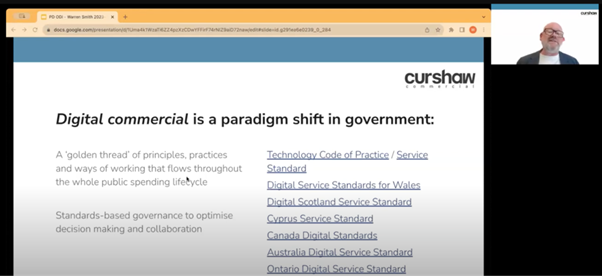On 26 October, ODI and Public Digital co-organised a webinar with Curshaw Commercial on agile procurement and digital transformation as part of our new BudgetByte series.
Entitled ‘Can agile procurement and digital transformation improve spending outcomes?’, the webinar looked at the relationship between the two and whether they can be used as levers to improve outcomes from public spending.
So, what actually happened?

Playback
Curshaw Commercial Partner Warren Smith kicked things off with a presentation that framed public procurement – the acquisition of goods, services and works on behalf of a public authority – as a crucial but under-leveraged tool that governments can use to address a wide range of challenges in public spending and service delivery. Smith talked about how approaches to designing, building and maintaining digital services and infrastructure must be indivisible from the heart of public procurement, namely delivering social value while meeting user needs. In doing so, he cited examples from Assam, Mexico City, Mongolia, Iowa, Indonesia, New Zealand and Wales. Smith concluded by discussing the need for principles, practices and ways of working to form a ‘golden thread’ that winds through the public spending life cycle.
We then heard from our panel of experts on how ‘agile’ procurement and digital transformation processes are playing out across different parts of the commercial life cycle and influencing public spending outcomes. These voices included David Kershaw, Founding Partner at Curshaw Commercial; Godfrey Ssemugooma, Acting Director of Financial Management Services in the Ugandan Ministry of Finance, Planning and Economic Development; Lindsey Marchessault, Director at the Open Contracting Partnership; and Snezana Mitrovic, Advisor for Procurement and Governance in the Global Practice at the World Bank.
The panellists talked about reconciling what agile procurement is with the promise it offers (e.g. being inclusive, participatory and principles-based), as well as the challenges in delivering on these aspirations of agile procurement in practice. They ultimately agreed that while there are many examples of public procurement leading to better (spending) outcomes and the commercial life cycle working well, agile project management methods alone are insufficient. What we need is more ‘empowered’ public procurement that can adequately address digital-era challenges.
What did we learn?
The panel discussion was wide-ranging, but a few key themes stood out:
1. The need for a ‘golden thread’ of principles, practices and ways of working
Smith framed the conversation by discussing the importance of thinking holistically about the entire commercial life cycle. ‘Digital commercial’ is a paradigm shift in government requiring a change in how we think about spending public funds. Decisions at different stages – and the choices we make to respond when things go wrong – can influence the success of public procurement as an endeavour altogether, requiring new and effective principles, practices and ways of working.
The panel elaborated on these points. Kershaw spoke about the importance of engaging suppliers early and making them a part of multidisciplinary teams and design processes to improve their ability to respond to changes. Meanwhile, Ssemugooma highlighted the importance of each actor in the value chain executing their role for procurement to be successful, and how the norms that influence how actors behave in delivery are established early in pre-procurement planning.
‘Digital commercial requires a “golden thread” through the whole public spending life cycle, represented by a consistent set of principles, practices [and] ways of working, [as well as] standards-based governance to optimise decision-making and collaboration. This will help to maximise transparency, objective and evidence-based decision-making, and competition. In turn, this will also help to promote a culture of integrity and responsible business conduct.’
2. Pre-procurement planning helps with early market engagement and determines the success of the entire commercial life cycle
Kershaw opened his remarks by noting the duty to spend taxpayers’ money well. To do this, the market must be taken seriously and existing and potential suppliers must be included early in the pre-procurement stage so that feedback can be heard. Only then can true collaboration between the public and private sectors happen, good delivery can be enabled, and public funds and resources can be better utilised.
Building on this, Ssemugooma argued that there is frequent system over-design. This often happens when requirements or specifications are put into procurement tenders which may not actually be needed, introducing a level of complexity that could have been counteracted through better dialogue about user needs – rather than solutions – during pre-procurement planning. Marchessault also emphasised that while pre-market engagement with suppliers could – and is often perceived to – carry integrity risks, it nevertheless helps suppliers to adopt requests for information, catalogue their needs and buy into the principles, practices and ways of working.
‘The market is not just suppliers; they only become suppliers when they supply something. You [have] got to entice them in. You [have] got to say: “Come and look at this big change programme – [this] transformation programme, the change we’re trying to do – and help us [work] to actually enact change.”’
3. Separating ‘folklore’ from law is critical to making more iterative and responsive procurement decisions within existing legal/regulatory frameworks
Ssemugooma discussed how each actor in the commercial value chain has to comply with a legal framework. In Uganda, for example, passing legislation and regulations for procurement is slow, as is the case in many markets. As a result, it is hard for individuals to comply with laws and regulations when some of them were only being enforced two years after they were introduced, by which time many of the motivations for a given procurement may have changed.
While the push and pull between legislation, regulation and soft governance was a common theme in panellists’ remarks, many were optimistic that it was changeable. Smith noted the importance of challenging what is actually 'law' (as opposed to what is local law or ingrained customary practice). Kershaw called it ‘folklore’, remarking how it was killing procurement by building up and creating perceived barriers.
‘No matter how good the systems are, no matter how good the procedures are, you have people presiding over these systems and these processes [...] Each of [these actors] has to play their role, and if they do not, that is probably the weakest link in this whole chain.’

4. More ‘empowered procurement’ can strengthen individual stakeholders’ roles in the commercial value chain
Marchessault questioned whether the framing of ‘agile procurement’ was positive (or even appropriate). She noted the potential need for a greater focus on ‘empowered procurement’ since attempts to use agile methodologies frequently come up against systems and policies that are anything but agile. As a result, the field needs more tools and processes to challenge the status quo and encourage experimentation, with the freedom to change and adapt over time.
Smith responded by noting that the key issue is the application of agile methods to improve procurement, and that procurement can never really be ‘agile’ in the truest sense. Agile project management is important, but so is having the right methods and approach for the right purpose – and to rigorously monitor what happens in practice. Mitrovic also stressed the need for ‘champions’ who can be empowered to lead throughout the commercial life cycle and work more iteratively.
‘What we need is agile project management and empowered procurement. Because the challenge is that, yes, you can tell people to be agile [and] be flexible, but then they come up against a system which is everything but agile and flexible. [They] need to be empowered by senior leadership with new policies, new frameworks, the freedom to think creatively and try new things. [...] But they can’t do any of those things if they’re not empowered.’
